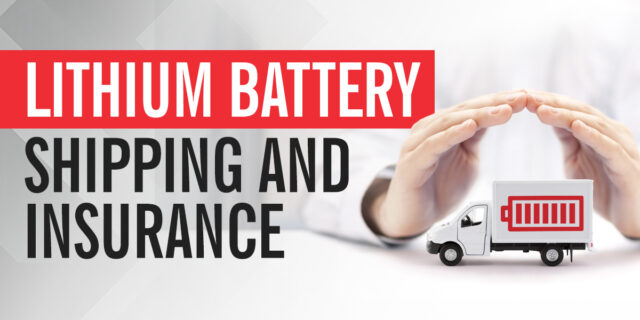
Shipping lithium batteries or battery-powered devices is an ongoing challenge. From the everyday batteries that power laptops and games to the larger batteries that power eBikes to the massive ones that power electric vehicles, complying with evolving regulations takes expertise and dedication.
But regulatory compliance isn’t the only challenge. What about insurance?
In recent years, the insurance industry has grown more aware of the risks and hazards posed by lithium battery transport. They’re applying greater scrutiny, and in many cases making coverage more expensive.
During our recent efforts coordinating large format lithium-ion battery logistics for a Fortune 100 company, we’ve developed best practices for securing the coverage we need at the most affordable rates. Here’s how you can leverage these best practices for your own lithium battery operations.
Insurance companies are reassessing the risks of lithium batteries
In 2021, the International Fire Code (IFC) classified lithium batteries as a high hazard commodity. The IFC is a model code, adopted by jurisdictions in the U.S. and around the world, that provides standards for fire prevention and safety in buildings and other structures.
The global supply chain, of course, has recognized lithium batteries as a significant hazard for a decade or more. That’s why regulations for transporting them are so strict. But this IFC classification means that many jurisdictions must implement additional fire protection measures for facilities that store or use lithium batteries—as New York City has recently done.
The IFC classification also put lithium batteries on insurance companies’ radar screens. Insurance companies have become wary of organizations that ship or store large volumes of batteries, particularly higher wattage batteries. They’re raising premiums and, in many cases, denying coverage.
Keeping coverage affordable for lithium battery operations
What makes insurance companies wary is the potential for lithium batteries to trigger a thermal runaway event that causes damage or injury. So, to keep your premiums manageable, take documented steps that prove you’ve done everything possible to prevent a thermal runaway event, and to mitigate damage if one occurs.
These steps should include:
- Having test summary reports available for all the batteries you handle, to prove they’re high-quality and not substandard knockoffs.
- Having safety data sheets on hand for all your hazardous materials—including all your lithium batteries.
- Having documented processes for all Dangerous Goods handling and thermal runaway mitigation.
- Using Dangerous Goods software that includes a comprehensive parts list to document the various hazmat items your operation handles.
- Using advanced lithium battery packaging that mitigates the effects of thermal runaway without allowing damage to its surroundings.
- Training all hazmat employees to understand the regulations for shipping and handling lithium batteries safely and compliantly.
If you have experienced a thermal runaway incident, you should perform a thorough root cause analysis to demonstrate that you understand exactly what happened—and how to avoid it a second time.
The more you can do to demonstrate a strong record of Dangerous Goods compliance, the more confident insurance companies will be that your operation is an acceptable risk.
Labelmaster experts can help you keep insurance manageable
When you’re evaluating insurance, the question isn’t just how much your policy costs. A more important question may be what your policy covers. Many policies actually have specific exclusions in their terms and conditions against thermal runaway or spontaneous combustion—meaning damages caused by a lithium battery incident may not be covered.
In addition, you should allow extra time if you’re adding or changing insurance policies. Due to the increased scrutiny insurance companies are applying to lithium battery operations, it can take longer than you expect to secure the coverage you need.
For help with these concerns—and the above list of best practices—you can always connect with one of the experts at Labelmaster Services. Our experienced DG professionals can conduct a one-day site visit or a comprehensive compliance assessment to help you identify improvements that can reassure an insurance underwriter.
When you ship lithium batteries, regulatory compliance is challenging enough. Make sure insurance doesn’t become an even greater challenge.
For any questions at all about Dangerous Goods safety, efficiency and compliance, call us at 800.621.5808 or contact Labelmaster online.
Labelmaster is a full-service provider of goods and services for hazardous materials and Dangerous Goods professionals, shippers, transport operators and EH&S providers. See our full line of solutions at labelmaster.com.



Hello,
Thanks for sharing content…nice post